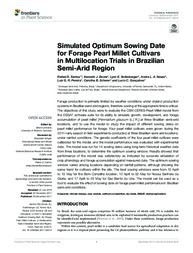Simulated optimum sowing date for forage pearl millet cultivars in multilocation trials in Brazilian Semi-Arid region.
Simulated optimum sowing date for forage pearl millet cultivars in multilocation trials in Brazilian Semi-Arid region.
Author(s): SANTOS, R. D. dos; BOOTE, K. J.; SOLLENBERGER, L. E.; NEVES, A. L. A.; PEREIRA, L. G. R.; SCHERER, C. B.; GINÇALVES, L. C.
Summary: Forage production is primarily limited by weather conditions under dryland production systems in Brazilian semi-arid regions, therefore sowing at the appropriate time is critical. The objectives of this study were to evaluate the CSM-CERES-Pearl Millet model from the DSSAT software suite for its ability to simulate growth, development, and forage accumulation of pearl millet [Pennisetum glaucum (L.) R.] at three Brazilian semi-arid locations, and to use the model to study the impact of different sowing dates on pearl millet performance for forage. Four pearl millet cultivars were grown during the 2011 rainy season in field experiments conducted at three Brazilian semi-arid locations, under rainfed conditions. The genetic coefficients of the four pearl millet cultivars were calibrated for the model, and the model performance was evaluated with experimental data. The model was run for 14 sowing dates using long-term historical weather data from three locations, to determine the optimum sowing window. Results showed that performance of the model was satisfactory as indicated by accurate simulation of crop phenology and forage accumulation against measured data. The optimum sowing window varied among locations depending on rainfall patterns, although showing the same trend for cultivars within the site. The best sowing windows were from 15 April to 15 May for the Bom Conselho location; 12 April to 02 May for Nossa Senhora da Gloria; and 17 April to 25 May for Sao Bento do Una. The model can be used as a tool to evaluate the effect of sowing date on forage pearl millet performance in Brazilian semi-arid conditions.
Publication year: 2017
Types of publication: Journal article
Unit: Embrapa Dairy Cattle
Observation
Some of Embrapa's publications are published as ePub files. To read them, use or download one of the following free software options to your computer or mobile device. Android: Google Play Books; IOS: iBooks; Windows and Linux: Calibre.
Access other publications
Access the Agricultural Research Database (BDPA) to consult Embrapa's full library collection and records.
Visit Embrapa Bookstore to purchase books and other publications sold by Embrapa.

